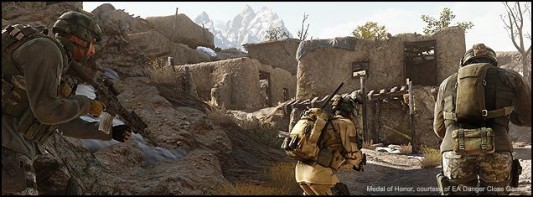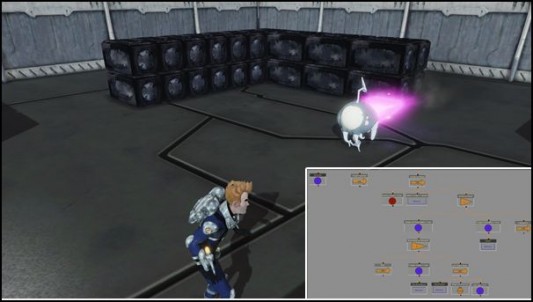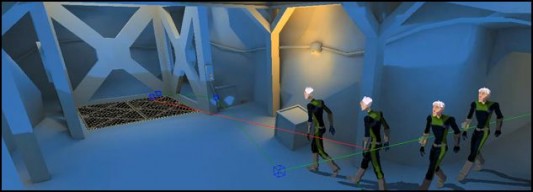Autodesk products have been used to create more than 1,000 games. As the market matures and changes, Autodesk is assembling a team and a product group to cover more of the game-building process.
By Kathleen Maher
It’s no secret that Autodesk has been gathering middleware game development technology for several years now, but at the recent Game Developers Conference in San Francisco, Autodesk revealed its plans more formally. Autodesk says their Gameware tools have been used in at least 1,000 games so far including Deus Ex: Human Revolution from Eidos-Montreal, Epic’s Gears of War 3, and Sony’s Resistance 3.

At GDC Autodesk introduced its Gameware group as a formal product group with new partnerships, and new middleware products. The company said its priorities in these early days are to look for partnerships, broaden its portfolio, and prepare for the future. Autodesk VP Marc Stevens notes that as the game market has evolved there is less of a mid-range market. The current generation of consoles is mature and the games are generally similar. The high end shooter market has not changed much. The customer base has perhaps consolidated to its more fanatical and dedicated core, but these people are still willing to invest in their games and the machines to play them on. As for the low end, there is a growing market for low-cost games for phones and tablets.
It seems inevitable that a new generation of console is going to come even though it’s far from certain there is a market for them. Nevertheless, Autodesk says they are preparing for the next generation of game platforms with new tools. Stevens says “over the past four years, we have been investing significantly in the area of runtime technology.”
The game industry has several big challenges. The process is too complicated, games are late, data and process management is only now just evolving. Costs are too high. Game development is complicated even for simple games and the process is unspeakable for complex 3D games.
Autodesk has identified an opportunity that exists for tools that help connect the disparate processes of game creation. The industry needs better ways to move content through the process of content and application creation. Artists, painters, modelers, animators, programmers still work in their own separate territories. Autodesk is interested in developing tools that cross those territories enabling better collaboration between all the teams involved in content creation.
FBX is the most basic example. It is Autodesk’s exchange format that enables content developers to exchange content for use in different programs. Skyline is another key component that Autodesk is working on to build connective tissue in the game development process. It is an ambitious project that seeks to build connections for artists and the middleware and programmers.

The idea is that Skyline will let people really see what they’re going to get. For instance a character can actually be put into the game engine where its motions can be experimented within context. This helps the artists understand how their character needs to be designed and the people creating interactive components and environments understand the characters they building environments for.
These tools can enable content to be created more efficiently. Reuse can be easier. Autodesk is calling the area they are building in the Gameware tools “art to engine.” At GDC Autodesk announced a licensing deal with Nintendo. Nintendo has licensed the Gameware middleware for its next generation of console. The Autodesk and Nintendo deal includes licensing for Scaleform, Kynapse, and HumanIK. Autodesk says they are working on similar deals with other companies. The company says they are developing tools for development for Windows 8 Metro.
Game development is a big jigsaw puzzle and Autodesk is adding pieces. It’s a good bet that this is where the company is going to look for new acquisitions. The tools is has now including tools for creating user interfaces, UI, tools for artificial intelligence (AI), and live scene authoring.
The puzzle pieces
Autodesk Scaleform is a UI tool for 2D content creation and applications. Autodesk has focused new development of Scaleform on tools for UI creation on the mobile platform. New features include extended support for Action Script 3. Autodesk has added support for BitmapData, AS3 XML and regular expressions. Autodesk has also done some work on Scaleform’s own UI. It has added a front-end client for Scaleform’s export/baking tool and has enabled a graphical preview of assets. Autodesk has also improved the Analyzer for Memory and Performance (AMP) tool for fine-tuning Flash applications, and it has also improved its GPU profiling capabilities.
Scaleform 4.1 has support for the Unity 3 engine and it will also support the Microsoft Windows 8 Metro platform.

Getting a grip
Autodesk was using technology from Montreal-based Grip Entertainment for its AI and character development tools. Last fall, the company went all the way and acquired GRIP’s technology, the Grip Character Control System and Grip Digital Extra System. Autodesk announced that Grip key employees Dr. Paul A. Kruszewski and Aaron Davey, along with all developers currently working on the GRIP technology will join Autodesk. Kruszewski and Davey are game development veterans who have developed tools in broad use. Kruszewski founded AI development company BioGraphic Technologies and worked at Artificial Mind and Movement as CTO. Davey was director of operations, game and entertainment for Engenuity Technologies, the company which eventually acquired Kruszewski’s BioGraphic. Davey was also at Ngrain, a 3D simulation and visualization company.
The deal closed in November 2011 and Autodesk isn’t talking about how much money was involved. The Grip technology adds new authoring tools using nodes and behavior trees. Grip also has technology that enables better control over NPCs (non-player characters) in a game.
In the realm of AI, Autodesk is announcing new tools or improved tools enhanced with technology acquired from Grip Entertainment. Cognition and Population are two new products and technology from Grip has also been used to add new features to Kynapse for real-time path-finding.
Cognition 2012 is a visual programming system with a run-time engine to create high-level artificial intelligence. Cognition’s tools give users behavior trees to create AI. Autodesk says the system is easy to understand and therefore it fosters better collaboration, it’s easier to debut, and the structure of trees and nodes help keep code organized.
Population 2013 is an AI tool for the Epic Unreal Engine 3. It lets users create and manage secondary characters. Autodesk says Gameware Population lets designers create worlds with hundreds of non-player characters. Kynapse can be used to give the NPCs a purpose in life. It enables realistic navigation. New tools include new path-finding tools so that characters can navigate around changing environmental conditions by updating path data in response to changing environments. Path smoothing enables more realistic movements. Also, technology added to Kynapse to reduces the size of AI bots. It enables developers to increase the numbers of NPCs in a game level.

Putting the pieces together
Beast is an example of a tools that can connect processes. It’s a relighting tool that artists can use within a game engine. The 2013 version of Beast features integrated lighting in the Unreal Engine. The Beast tool includes interactive previews in the viewport. Its global illumination mode makes lighting easier and decreases configuration steps.
HumanIK is an animation tool that helps animators get realistic character movements with just a few steps. It has a simplified two-bone IK solver, a new shoulder solver, and improved spine solving with a new tool for controlling spine curvature. Autodesk has improved the HumanIK plug-in for MotionBuilder so users can fine tune animation.
To get back to its evolving technology, Project Skyline, a little bit more, Autodesk was careful to position the project as “future technology” that’s evolving as Autodesk gets more involved in all aspects of content creation. The company’s showcase technology is Live Linking, the ability to see characters in a game engine from the Maya environment. The team is also improving its visual programming tools. The node and behavior tree tools in Grip are examples that add to the technology Autodesk has been building on this front.
The Softimage team within Autodesk had a good jump on visual programming too. Some of those people spun out to form Fabric Engine for a tool that can be used in a broad range of applications.
Project Skyline is taking visual programming and adding live linking which will make it easier to debug complex animation setups. Programmers can build custom nodes that can be used by artists, and animators to get defined, expected results. Autodesk says that work is also going on within Project Skyline to build an animation engine that can be integrated into a game engine so that content creators can build actions and interactions directly and programmers can be freed to work on low-level animation and data translators.
Working on the big vision
Autodesk is taking on jobs that had previously been done by the game development companies on a case-by-case basis. There are going to be people who don’t like the idea of Autodesk taking on more of the process and it’s true that as the company owns more of the process, it’s likely to be more difficult to integrate outside products into the process unless Autodesk provides plenty of hooks. The idea of making game development more easy and interactive is absolutely entrancing. It’s like so many digital development processes we’re struggling with today. If you can remove some of the complexity of the process, the doors are opening for a new generation of creator who can worry less about the complexities of creation and worry more about the quality of the content.





